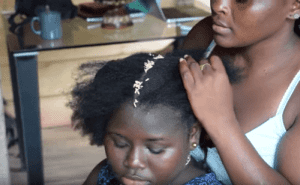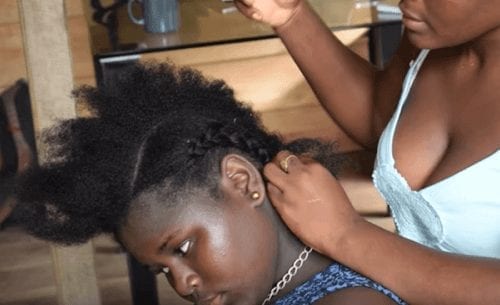How Enslaved Africans Braided Rice Seeds Into Their Hair & Changed the World

The Maroon tradition of braiding rice in hair to hide the seeds had developed during the African slave trade. {Source: Tinde van Andel}
April 5, 2020 ~ By Shari Rose
Updated September 21, 2021
On slave ships to the Americas, enslaved West Africans braided rice seeds in their hair & forever altered the New World economy with their knowledge of the rice crop

Bundle of harvested rice gathered by a Maroon farmer in French Guiana. {Source: Tinde van Andel}
During the African slave trade, enslaved peoples found ways to retain their agency, and keep themselves and their cultures alive in ways that were not widely acknowledged by Western historians until the late 2000s. As Dutch slave owners forcibly transported people from West Africa to colonies in modern-day Brazil and throughout the Americas, some African women, namely rice farmers, braided rice seeds into their hair as a means for survival of themselves and the culture of their homeland.
These seeds were safely transported to the New World, and became one of the primary ways that the rice crop came to be cultivated in the Americas, from Brazil to South Carolina. As research shows, West African women were the main contributors to the success of rice farming, due to their knowledge and practice in not only transporting seeds, but also cultivating the plant for mass consumption in a lucrative and exploitative plantation economy built on slavery.
Braiding Rice Seeds Into Hair, As Taught By Descendants of the Maroons
Dutch ethnobotanist Tinde van Andel provides a wealth of research on tracing back the movements of African rice species in from West Africa to French Guiana and Suriname, the eventual homes of the descendants of those who escaped slavery on Dutch plantations. The descendants of these enslaved Africans are collectively known as the Maroon people.
Rice farming, backbreaking though it may be, is predominately women’s work, and the vast majority of Maroon rice farmers are women.
During Andel’s work during July 2017 in French Guiana, she spoke at length with a woman descendant of the Maroon people named Edith Adjako, who demonstrated the African braided hairstyle that enslaved West African women used to hide and transfer rice seeds from their homeland to the Americas. Edith shares the story passed to her from her grandparents, as well as other Maroon tribes, including Saramaka and Aukan.
More stories: John Mitchell Jr.’s Relentless Fight For Justice At The Richmond Planet
More stories: How Nzambi Matee’s Plastic Bricks Combat Pollution In Kenya
More stories: First Laugh Ceremony: A Joyful Navajo Celebration of Family
Maroon Tradition of Braiding Rice Into Hair During African Slave Trade

Hiding rice seeds in braided hair as part of Maroon tradition that dates to African slave trade. {Source: Tinde van Andel}
As she carefully held a portion of hair to one side and placed rice seeds along the girl’s scalp, named Marion, Edith began sharing this oral tradition:
“In times of slavery, when our ancestors came to Suriname, they could not bring a bag or luggage to bring their belongings.”
With seeds in her hand, Edith said: “If you have a little, it stays inside … In this way, she had rice seeds that she could plant again, in her hair. In this way, she succeeded to bring a little rice, and this is why the people have rice here to plant.”
In an effort to carry rice seeds with them before being held captive on a ship headed for the New World, a rice farmer created a braided hairstyle for herself that successfully transferred these critical seeds.
“And now I will show how it was done, how it happened.” Edith then covered the rice with a right braid that followed from the girl’s forehead to the back of her neck. No visible rice seeds remained.

Finished braid that hides rice seeds in Marion’s hair. {Source: Tinde van Andel}
Edith continued, now speaking about the origin of her ancestors, the Maroon peoples, and their escape from slavery.
“Because they were all together, and when they were still on the plantations, when they escaped, some people went with a group to one side, others went with a group to another place. And this is how they became separated. So they became Saramakans, Aukans, Paramakans, Aluku’s … the different tribes.”
When Edith finished braiding the rest of Marion’s hair, replete with rice seeds, Marion stood up and forcefully shook her head back and forth. No seeds fell to the floor.
Edith shook her head and exclaimed, “Nothing comes out at all! This is how it happened.”
Share this story
 |
 |
 |
 |
 |
 |
Through this method, enslaved West Africans kept alive the very crop that sustained their bodies and their culture in one of the few things they still had autonomy over: their hair. By braiding rice into their hair, some ingenious West Africans helped ensure that parts of their culture and homeland in could be carried with them.

Marion shakes her head to show that rice seeds remain in place beneath the braids. {Source: Tinde van Andel}
Maroons Escape Slavery on Dutch Rice Plantations & Head for the Forest
Between 1670 and 1860, enslaved West Africans escaped from the Dutch empire and began to settle in the nearby rainforests in modern-day French Guiana and Suriname. These people who fled enslavement on rice plantations came to create their own society, and collectively became known as the Maroon people.

Maroon farmer plants rice seeds in French Guiana. {Source: Tinde van Andel}
Within Maroon society exists a number of tribes that Edith mentioned, including the Saramaka, Paramaka, Kwinti, Aukan, and more. With their superior knowledge of agricultural practices, including rice cultivation, Maroons thrived in the interior rainforests off the eastern coast of South America. Well-insulated from Dutch colonies, Maroon culture is exceedingly unique, from religion to music, language and more. Additionally, rice plays a major role in Maroon culture, particularly in ritual practices.
More stories: Yuri Kochiyama At The Intersection of Black Power & Asian Movements
More stories: Lucy Hicks Anderson: Black Transgender Pioneer of the 1940s
More stories: The Triumphs of Edward Gardner at the 1928 Bunion Derby
Tracing Rice Species From the Americas Back to Africa

Maroon rice farmers and researcher Andel trying to determine different species of rice they found in a neighbor’s farm. {Source: Tinde van Andel}
Recent research into the specific species of the Maroons’ staple rice, O. glaberrima, including a full sequencing of its genome, has provided even more information that further demonstrates that Africans had been cultivating rice well before European traders made their way to the continent.
In 2008, the discovery of Africa-descended rice in a Maroon field in Suriname provided further evidence that enslaved African peoples had the agency to not only retain crops from their homelands during their enslavement, but also to cultivate using the same farming techniques by Maroons.
Furthermore, African languages surrounding the rice crop provide insight into its origins. In parts of Africa where rice cultivation was already practiced before white colonists appeared, indigenous names for rice are used. The names for rice in these regions originated from native African languages including “mano” and “malo.”
In other regions of Africa where rice was not being farmed prior to the arrival of Europeans, the word for rice is borrowed from Arabic and European names, such as “arroz,” “riz”, “erruz,” and so on.
Researchers on this project, which includes Andel, make the case that this new evidence about the autonomy of enslaved West Africans to preserve crops from their homelands provides an “incentive to re-examine historical sources to trace the way African rice ended up in the New World and why it was cultivated by enslaved Africans and their descendants.”
How Enslaved Africans Saved the Rice Crop On South Carolina Plantations
To sustain the growing populations of South Carolina colonists and the people they enslaved, it took more than the act of braiding rice into hair to transport seeds from Africa to the Americas aboard slave ships. It also took the expertise of enslaved West African women to then plant, cultivate and harvest this rice, skills that European colonists relied heavily upon.

Rice farmer in French Guiana displays her harvest. {Source: Tinde van Andel}
Early colonists in South Carolina did not know how to farm rice. According to UCLA researcher Judith A. Carney, Western history accounts typically attribute the colonists’ ability to farm rice en masse on a stroke of genius, but it was in fact enslaved West Africans who had been farming rice for generations that imparted this knowledge which eventually helped to develop the plantation economy in the U.S.
In South Carolina and Georgia, enslaved African women were the prime laborers on rice plantations. Women’s work included sowing the rice seeds, weeding, hoeing and threshing. There was also the manual milling process of removing inedible husks so the rice could be consumed. Carolina’s coastal wetland provided excellent farming land for the crop, and rice flourished.
And as with the Dutch colonies in South America, Carney says the appearance of rice in South Carolina was not due to stroke of genius on the part of European colonists, but rather the farming knowledge from enslaved West Africans who were forcibly brought over:
“The history of rice cultivation surrounding the Atlantic basin, however, suggests that the crop’s appearance in South Carolina was not the outcome of European agency and ingenuity but the result of a sophisticated knowledge system of wetland cultivation brought by involuntary black migrants.”
More stories: The Fate of Margaret Morgan in Prigg v. Pennsylvania
More stories: Enietra Washington: Only Confirmed Grim Sleeper Survivor
More stories: The Forgotten Anti-Filipino Watsonville Riots of 1930
Contributions of Enslaved Africans in Historic Accounts

Maroon rice farmers look at researcher’s findings of different rice species in the region. {Source: Tinde van Andel}
Until the 20th century, historians long believed that the introduction of rice into West Africa came from the Portuguese, who originally brought the crop over from Asia. Even as growing evidence suggested that Africans were growing rice before European colonists had appeared on the continent, the narrative still held that Asia was the origin of this rice, and Arab traders must have introduced it to Africa in their travels.
However, through the 2008 African rice genome study and further language evidence, research shows that rice farmers in West Africa, particularly female rice farmers, had been perfecting the practice for generations before.
As Carney puts it:
“Rice has always been a crop associated with women. In attributing rice origins to their ancestors, maroon legends reveal the ways in which the enslaved gave meaning to the traumatic experiences of their own past while remembering the role of the cereal in helping them resist bondage, survive as runaways, and commemorate cultural identity.”

French Guiana woman dehusks rice in the traditional Maroon way. {Source: Tinde van Andel}
Conclusion
Over the course of tens of thousands of transatlantic voyages during the African slave trade, more than 10 million Africans were forcibly transported to the New World. Most Western historical accounts paint the discovery of rice in the New World with the brilliance of European colonists and discoverers who brought rice from Asia. However, it was African women bound in slavery who braided rice seeds critical to their culture and survival into their hair, allowing the crop to flourish in plantation economies and sustain the colonists who captured them.
Today rice is a stable component of Brazilian culture and diet. In the U.S., you can’t have gumbo in the South without rice. The availability and popularity of rice in the Americas is inextricably linked to the efforts of enslaved West Africans who refused to leave a small piece of their homelands behind in the face of lifelong bondage. As white men came to forcibly remove them from their homes for a life of enslavement, many ingenious Africans braided rice into their hair, committing a final, defiant act of autonomy, even as they and their families lost everything.
And through the work of researchers like Andel and Carney, perhaps the record can begin to be set straight in properly documenting the world-altering contributions of enslaved Africans throughout human history.
Many of the images used in this post are pulled from Andel’s YouTube channel, which offers a number of firsthand accounts from the Maroon people. If you’re interested in learning more about these incredible people, please check out Andel’s work!
More stories: Esther Jones: Betty Boop’s Original Influence
More stories: George Washington’s Fight for Smallpox Inoculation in Revolutionary War
More stories: Gallus Mag, The Most Brutal Bouncer in 1860s New York
Share this story
 |
 |
 |
 |
 |
 |







The term you’ve used a plethora of times, “slaves” West African Slaves” “African slaves” is DEMEANING! They were ENSLAVED AFRICANS. Not just “slaves”. As if they had no other course in life but to be slaves. Correct your usage.
Hi Tiffany,
I totally agree. All instances of “slaves” have been removed from this article. Thank you for letting me know!
I found this article & the accounts given ny the ancestors of enslaved women bringing a part of their culture with them, to be very inspiring.
As in the case of war, history is written by those who consider themselves to be the “victors”.
Its not surprising to learn that in America’s often sordid history, that practice was commonly done in regard to the important contributions brought here & to new countries by enslaved persons.
It’s never too late to rewrite our history & to correct the misconceptions, slights, or lies, and reassign credit where it’s rightly due.
Thank you for gathering this lost history about Americas early roots!
I cried many times reading this! So empowering.